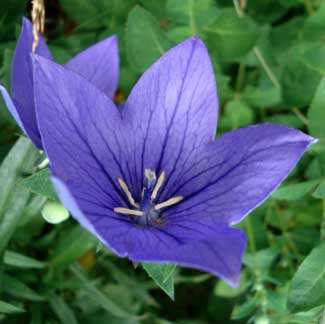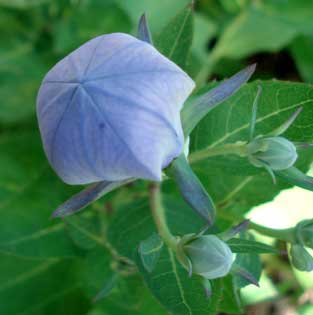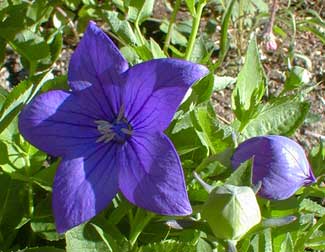
'Astra Blue'
Dwarf Balloon Flower
"There is more pleasure in making a garden
than in contemplating a paradise."
-Anne Scott-James
(Lady Lancaster),
b. 1913
(Lady Lancaster),
b. 1913
'Astra Blue' is a compact dwarf form of Platycodon grandiflorus hybrid Balloon Flower. This long-lived perennial forms a tight clumping ball of leaves eight inches to a foot tall & wide. Only the foliage is dwarf; the flowers are as large as tall full-sized cultivars.
 Planted eight inches apart they can form a long-flowering groundcover. It grows easily from seed, does well in containers & window boxes, & is a good edging or rockery plant.
Planted eight inches apart they can form a long-flowering groundcover. It grows easily from seed, does well in containers & window boxes, & is a good edging or rockery plant.Native to east Asia, balloon flowers are also known as Chinese or Japanese Bellflowers, or Jie-Geng. The roots are toxic raw, but properly cooked are perfectly edible, rich in calcium, & highly valued in Oriental cuisine. Roots are harvested when two or three years old, & treated a bit like burdock root or it will be bitter. Before frying, pickling, or adding to soups, the root is skinned, & blanched in salt water, then ready to cook.
The mature lower-most leaves may also be mildly toxic, but safe if they have been dried & powdered as a soup flavoring. The tender uppermost leaves are not toxic, & are commonly used in salads. Like a lot of vegetables & fruits, balloon flower root can function as an antioxidant & immunostimulant, so truly qualifies as a health food.
In Chinese herbal medicine, the roots are alleged to have healing value for just about all ailments of the lungs & throat, by "circulating chi of the throat & restoring the balance of yin. It is used either as a tonic tea of boiled roots, or small chunks sweetened with honey.
 The scientific studies have not been convincing that balloon flowers have any helpful respiratory benefit. Plus, as traditionally prepared by boiling, the more potent chemical components break down, losing both toxicity & much likelihood of medicinal activity. But facts will never weaken its popularity as a herbal remedy.
The scientific studies have not been convincing that balloon flowers have any helpful respiratory benefit. Plus, as traditionally prepared by boiling, the more potent chemical components break down, losing both toxicity & much likelihood of medicinal activity. But facts will never weaken its popularity as a herbal remedy.The root does contain numerous chemicals that might yet prove beneficial for something or another, though the herbal traditionalists seem not to have lit upon what that might be by means of yin/yang philosophy alone, though the traditionalists in light of suggestive scientific research have modernly extended the use to include treatment of elevated cholesterol, hypertension, & especially diabetes.
In a South Korean study in 2000 at Dong-A University, dietary platycodon was fed to obese lab rats, & found to have a slight impact on insulin & blood glucose levels. The benefit was statistically insigificant, but suggestive that further investigation was warranted to assess the potential value in treating metabolic disorders, diabetes, heart disease.
It thrives in zones 4 through 8. It best likes full sun but tolerates a bit of shade, & prefers medium-moist extremely well-draining organically rich soil, but can be attempted in droughtier positions.
Blooms begin in July & last until first frost, especially if spent flowers are periodically picked off. The blooms are about three inches wide with thicker petals than most balloon flowers & of an intense blue similar to blue dalmation bellflowers.
Just before the buds burst open they form charming round balloons for which this perennial is named. The balloon-buds & opened blossoms last well as cut flowers, although for the cutting garden, taller variety would likely be preferred, as full-sized varieties grow two or three feet tall.
After winter dormancy, the clumps reappear quite late in spring so the location should be well-marked so as not to be dig near or damage the sensitive crowns.
The roots dislike disruption & little clumps should not be molested once they are established. If necessary division is possible if done carefully, but propogation is best performed by collecting the ripe seed in August or September & starting them in coldframes or pots, planting them in their permanent locations very late the following spring or early summer.
Continue to:
Platycodon grandfiflorus 'Fuji Pink'